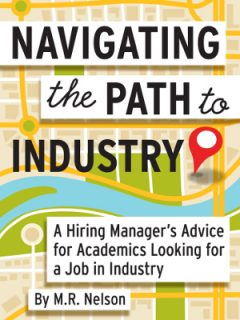Navigating the Path to Industry
A Hiring Manager’s Advice for Academics Looking for a Job in Industry
By M. R. Nelson
Annorlunda Books, 2014
Navigating the Path to Industry is a short book that aims to demystify the basic steps academics and graduate students in the sciences need to take when conducting their first job search in industry. The book’s intended reader is someone who is well versed in academia’s standards but lacks the exposure to the standards that operate in industry.
Throughout, the focus is on securing a first position, and not necessarily one to which the reader might aspire. In the midst of a career transition, the logic goes, it is prudent to target a position that may not represent everything one hopes to achieve in industry, but where one can stay for a couple of years while acquiring the experience needed to thrive in future roles.
Nelson, whose background is in biomedical science and information technology, clarifies her book’s objective by stating early on that her intention is to provide a framework for conducting the job search, not offer a holistic treatment of the intricacies involved in career transitions. “You will need to fill in the details for yourself,” she says, “based on your own particular skills and goals.” She adds that Navigating the Path to Industry does not replace full-fledged books on career transition. Instead, it serves as a starting point.
Overall, three pieces of advice stand out:
First, the biggest mistake you could make is to wait “until you need a job to start the process of looking for one.” Even in the best of circumstances, finding a position in industry is a time-consuming process that could take several months—even up to a year. The process involves research, self-inventory, and networking, all of which require a great deal of time and reflection. Failing to do this work beforehand would almost certainly sabotage your chances of making a smooth transition from academia to industry.
Second, it is crucial to learn the professional version of your academic field. Research how your specific academic expertise is applied in industry. Why do industry practitioners apply the expertise differently? Is it because they value reliability more than innovation? Try to find out the “how” and “why” while resisting the temptation to dismiss the different methodologies deployed in industry as deficient, because there is often a perfectly logical reason for that difference.
Third, put a considerable amount of energy into preparing to network. Before you even start networking, prepare a compelling but brief summary of your research—one that is intended to start a productive conversation, not answer all possible questions about your research and expertise. Most importantly, never network “to get a job.” Rather, network to learn about the available options and “to plant seeds” that will bear fruit in the future.
Written in condensed, conversational style, Navigating the Path to Industry offers practical advice along the lines of the ones mentioned above, all without requiring a substantial time commitment on the part of its reader.
For more book reviews, visit our Bookshelf.